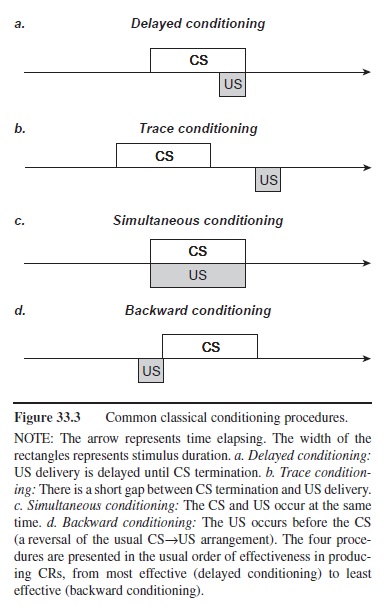Find Free Essays
· The Classical Conditioning initiates to predict about the ways the conditioning is influenced by some pathologies being well settled on a behavioral and neural basis. eally, classical conditioning is better understood and is so similar in animals and humans and it is effective in analyses which attempt to connect human disorders to brain dysfunction In brief, classical conditioning combines a stimulus with an unconditioned response and a stimulus with no conditioned response. Through repetition of this combination, it is expected that eventually the stimulus that previously had no response would now have a response, that being the conditioned response (PsychPost, ) Classical conditioning can be describe as a reflexive or automatic type of learning in which a stimulus acquires the capacity to evoke a response that was originally evoked by another stimulus. It was first described by Ivan Pavlov (), a Russian physiologist, in , and studied in infants by John B. Watson ()
![What is Classical Conditioning: [Essay Example], words GradesFixer](https://onlinepmcourses.com/wp-includes/images/2012-8/classical-conditioning-research-paper.jpg)
Related Essays
· The Classical Conditioning initiates to predict about the ways the conditioning is influenced by some pathologies being well settled on a behavioral and neural basis. eally, classical conditioning is better understood and is so similar in animals and humans and it is effective in analyses which attempt to connect human disorders to brain dysfunction · Classical conditioning/ systematic desensitization essay Pages: 4 ( words) Comparing Classical and Operant Conditioning Pages: 3 ( words) Human Mind and Classical Conditioning Pages: 4 ( words) Classical Conditioning Pages: 1 ( words) Learning Through Classical and Operant Conditioning Pages: 3 ( words)Estimated Reading Time: 5 mins Classical conditioning can be describe as a reflexive or automatic type of learning in which a stimulus acquires the capacity to evoke a response that was originally evoked by another stimulus. It was first described by Ivan Pavlov (), a Russian physiologist, in , and studied in infants by John B. Watson ()

Describe the theory of classical conditioning
· Classical conditioning/ systematic desensitization essay Pages: 4 ( words) Comparing Classical and Operant Conditioning Pages: 3 ( words) Human Mind and Classical Conditioning Pages: 4 ( words) Classical Conditioning Pages: 1 ( words) Learning Through Classical and Operant Conditioning Pages: 3 ( words)Estimated Reading Time: 5 mins Classical conditioning is “a type of learning through which an organism learns to associate one stimulus with another” (Wood, Wood, and Boyd ). Learning implies that there is at least a semi-permanent change, this change could be demonstrated through behavior for example. In classical conditioning two stimuli are paired together multiple times Classical conditioning can be describe as a reflexive or automatic type of learning in which a stimulus acquires the capacity to evoke a response that was originally evoked by another stimulus. It was first described by Ivan Pavlov (), a Russian physiologist, in , and studied in infants by John B. Watson ()
classical conditioning
· Classical conditioning/ systematic desensitization essay Pages: 4 ( words) Comparing Classical and Operant Conditioning Pages: 3 ( words) Human Mind and Classical Conditioning Pages: 4 ( words) Classical Conditioning Pages: 1 ( words) Learning Through Classical and Operant Conditioning Pages: 3 ( words)Estimated Reading Time: 5 mins Classical conditioning can be describe as a reflexive or automatic type of learning in which a stimulus acquires the capacity to evoke a response that was originally evoked by another stimulus. It was first described by Ivan Pavlov (), a Russian physiologist, in , and studied in infants by John B. Watson () · The Classical Conditioning initiates to predict about the ways the conditioning is influenced by some pathologies being well settled on a behavioral and neural basis. eally, classical conditioning is better understood and is so similar in animals and humans and it is effective in analyses which attempt to connect human disorders to brain dysfunction

Introduction
· Classical conditioning/ systematic desensitization essay Pages: 4 ( words) Comparing Classical and Operant Conditioning Pages: 3 ( words) Human Mind and Classical Conditioning Pages: 4 ( words) Classical Conditioning Pages: 1 ( words) Learning Through Classical and Operant Conditioning Pages: 3 ( words)Estimated Reading Time: 5 mins · Behavioral therapies are based on the theory of classical conditioning. The principle of behavioral therapy is all behavior is learned. Faulty learning (i.e. conditioning) is the cause of anomalous behavior. The aim of the behavioral therapy is to focus on current behavioral issues and on efforts to remove the undesirable behaviors · Classical Conditioning Essay. Classical conditioning is a theory of learning that was discovered by Ivan Pavlov. According to the theory, a new behavior is learned through the process of association. According to the theory mentioned above, two or more stimuli are paired to produce a response. The output response is later [ ]
No comments:
Post a Comment